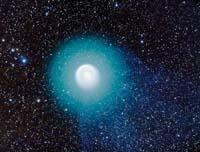Star or kite?

Astronomers have been mixed by a new space light point. Some of them thought they found a new star because they saw a new smile. But comet observers gave the explanation to this glow: it was not a new star, but a comet. The instant and enormous brightness was responsible for the mix.
Although some have confused, comet observers knew the comet long ago. It was discovered in 1892 and was called 17P Holmes. However, suddenly, the luminosity measurement scale of the comets rose from 17 to 2 in October. That is, it multiplied a million times its brightness and, in December, it was still visible to the naked eye from Earth. Comet that looked like a blurred star for anyone looking to the sky. To measure the luminosity of the stars, a scale of magnitudes is used and the smaller the number is clearer. At first glance, only those of less than 6th magnitude can be seen and cannot be seen with the best telescope of more than 30th. Therefore, before this sudden boom it was impossible to inspect this comet without telescopes.
Astronomers still don't know why the 17P Holmes luminosity has increased so much. They believe that the ice core of the kite may be broken. Thus, the solar rays would penetrate the core, melt the ice and produce a huge fracture. As a result of the breakage, the comet's core would shed large amounts of gas and dust, and that projected material would reflect more sunlight and cause that abnormal luminosity, since comets do not have their own lighting.





